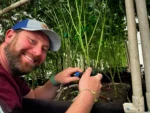Cannabis cultivars come genetically preloaded with their ultimate yield potential. But too often, cannabis growers aren’t reaching that potential because they don’t give their crop all the resources it needs to maximize photosynthesis.
Ensuring peak availability of lighting and irrigation can help indoor cannabis growers “close the yield gap,” says Ben Higgins, Ph.D. Higgins is chief scientist at KIS Organics, an organic farming supply company, and the research scientist for Gold Leaf Gardens, a Washington state cannabis farm. Higgins observed yield increases of more than 50% in an indoor grow setting after optimizing water availability using Blumat®’s auto-watering drip emitters and then maximizing his grow’s light conditions with BIOS Lighting’s Cannabis Grow Lights.
Ways to Increase Cannabis Plant Yield
In this article, BIOS Lighting interviewed Higgins about his experience optimizing lighting and irrigation to work together to boost cannabis crop yields. BIOS Lighting designs and manufactures LED lighting that maximizes photosynthesis and plant growth by focusing on the key ways lighting promotes a plant’s potential. BIOS Lighting was founded by former NASA scientists who developed the original technologies to provide light to grow crops in space.
Adjust Variables Accordingly
Cannabis growers need to be prepared to adjust for variables in their operations, Higgins says. Changes in scale, methodology or equipment can have downstream impacts. For instance, boosting growth rates often means higher demands on HVAC loads.
As indoor growers scale into larger facilities or transition from an outdoor to a controlled environment, they are not always prepared for the impact of changing variables within their grow. Techniques that worked fine when they were smaller − like every other day scheduled hand watering − suddenly may not be enough to support their crop’s growth needs.
“What a plant experiences in its environment will directly impact its ability to uptake nutrients. The amount of photosynthetic light it receives will dictate so many different things both above and below ground,” Higgins says.
Lighting and irrigation are two systems that work symbiotically for the best results. But, at worst, can result in unanticipated problems, Higgins says. Better lighting boosts photosynthesis, plants’ respiration rates increase and the crop’s demand for water grows. But growers need to be careful to avoid overwatering as much as underwatering.
“Depending on the light source that’s coming down above it, those plants could be really, really thirsty. Or just fine,” Higgins says. “But if you’ve been growing at 800 to 900 PAR you put in some big LEDs in and now you’re at 1100, well those plants are going to need water more frequently. And if you don’t adjust your hand watering schedule accordingly, there could be issues.”
Implement Automated Irrigation System
Irrigation that occurs as cannabis plants need it, rather than per a schedule, means growers can ensure their plants are receiving water at their optimal levels, automatically adjusted for light levels, growth stages and any of the many other variabilities that impact water demands, Higgins says.
For those reasons, Higgins is a big fan of the Blumat irrigation system for indoor cannabis growers for its ability to manage watering variabilities.
Blumat is an auto-watering system that relies on osmosis to work. As the soil in a bed dries out, the Blumat sensors (cavities inserted into the grow bed filled with water) decrease in pressure. This lowered pressure flips open a valve and allows water to flow out until pressure is equalized throughout the bed and the valve automatically shuts off. Blumats are not electronic, they work entirely off water pressure, so they aren’t affected by power outages.
For cannabis growers, Blumats have apparent advantages, Higgins says. They reduce labor (i.e. hand-watering) and eliminate the variability of water needs between cultivars and grow room micro-habitats. They also take the guesswork out of watering during different growth cycles, like vegetative versus flowering. But Higgins also likes Blumats for how well they support other systems within a cannabis grow. For instance, if the lighting is optimized and plants increase their photosynthesis, the Blumats automatically respond with more irrigation.
In his experiments at Gold Leaf Gardens, Higgins installed the Blumat system first, then switched from an HPS to the BIOS LED cannabis grow lighting system. Once they changed the lighting, he noticed an immediate increase in how much water the beds under the LED lights were consuming compared to the beds still under an HPS lighting system.
“The actual morphology, the actual physical appearance of the plants changed. It was a very clear indication of us closing the yield gap. We had been growing the same cultivar for over a year at Gold Leaf, and the second we threw plants under LEDs with Blumats, we were seeing fan leaves we’d never seen before. With this particular cultivar, plants were at least 50 to 75% larger,” Higgins says.
Slow and Small Changes are Best for Increasing Cannabis Yield
Ultimately, growers have to successfully manage all variables in a controlled environment agriculture− the growing medium, nutrient management, lighting, irrigation and HVAC – so they work together to close the cannabis yield gap, Higgins says. The trick is in making changes and then adjusting for impacts.
The type of soil or growing medium affects drainage. Light intensity may amplify how quickly the plants grow and how fast the medium dries out. A medium that wicks up moisture quickly and dries out rapidly will require more watering sensors to detect and respond to watering needs appropriately. And as plants respond with increased growth rates, the HVAC needs to work harder to keep up with humidity, temperature, and airflow requirements.
“Especially in an indoor grow, all these things really play together. Every time you move one dial, you twist this one just this little bit, then that one changes. You’re always kind of playing variable whack-a-mole,” Higgins says.
For those reasons, Higgins advises growers to start small with any changes. For instance, change out just one room instead of switching over an entire operation from a synthetic growing medium to a living soil like KIS Organics living soil. Or, if a grower has five beds, install Blumats into one of them to trial the system.
“Whenever you make an adjustment to your systems, do it small and give it time,” Higgins says. “How’s the new workflow? Do you like the design? If it works, fantastic. But let’s make sure everybody is on the same page on how the whole thing works together before you take the plunge.”
For more info on Higgins’ work with automated irrigation systems in controlled environment operations, refer to his whitepaper. KIS Organics also offers customized Blumat designs. For a customized cannabis lighting plan reach out to BIOS Lighting’s cannabis expert team.


